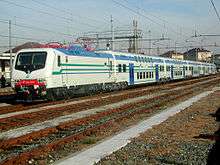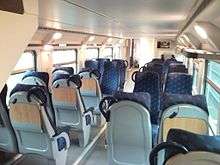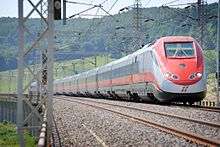Trenitalia
 | |
| State-owned subsidiary | |
| Industry | Rail transport |
| Founded | 1905 as Ferrovie dello Stato Italiane, 2000 as Trenitalia |
| Headquarters | Rome, Italy |
Key people | Barbara Morgante (CEO), Tiziano Onesti, (Chairman) |
| Products | Transport |
| Revenue |
|
| Owner | Ferrovie dello Stato Italiane (100%) |
Number of employees | 31,802 (2014) |
| Website |
www |
Trenitalia is the primary train operator in Italy. Trenitalia is owned by Ferrovie dello Stato Italiane, itself owned by the Italian Government. It was created in the year 2000 following the EU directive on the deregulation of rail transport even if the company privatisation was only formal as the Italian government ultimately retains a 100% interest.
History
The Italian government formed Trenitalia to comply with European regulations. The European Commission's First Railway Directive from 1991 (91/440/EC) prohibited that the same railway company manage the rail infrastructure and provide rail transportation. On 1 June 2000, therefore, Italy created Trenitalia as the primary rail transportation company and on 1 July 2001 established Rete Ferroviaria Italiana (RFI) as the company overseeing the rail network.[4] However, the separation was only formal, since both are subsidiaries of the Ferrovie dello Stato Italiane holding and are owned wholly by the government.[5]
Passenger transport

Trenitalia offers national rail transport in Italy and international connections to Austria, France, Germany, and Switzerland.[6]
The company operates both regional and long-distance trains.
Regional trains

Regional trains travel within an Italian region or between neighboring Italian regions. Trains usually stop at all stations at most, thus connecting small centres to cities. Regionale veloce (fast regional train) are trains stopping at about half of station stations at most.

There are no reservations for regional trains, and for this reason, there is no price advantage to acquiring regional tickets in advance online.[7] Once bought, tickets for regional trains have to be validated at the station before departure.
"Validation" in this case means placing a date/time stamp on the ticket by inserting into a (usually) green and white box either in the station or along the track. This is done because regional tickets are not for a particular date or time but are valid for a period (two months for tickets bought before 1 August 2016). The date/time stamp is to show that the ticket cannot be reused.
From 1 August 2016, tickets are valid for the 24 hours choosed by online buyers; the date of use can be changed until the previous 24 hours of the later date. The date of use can be anticipated until the 24 hours following this adjusting operation. The omission about the period of use at paper shops will involve a one-way daily ticket issue. This change aims to hinder fare evasion.
There are no discount schemes available for non-residents of Italy on regional trains.
Long-distance trains and High Speed Trains

Long-distance trains are of mainly of two types: the Frecce (arrows) and Intercity trains.
Intercity trains also serve medium-sized cities besides the big cities, thus are generally slower but are cheaper than the Frecce.
Night trains (Intercity night) operate mainly between north and south of Italy and between Italy and its neighbouring countries and are comparable to Intercity level.
High-speed rail (managed by RFI) service in Italy commenced in 2008 with about 1,000 km (620 mi) of new track on the Turin-Milan-Bologna-Rome-Naples-Salerno route that allow trains to reach speeds over 360 km/h (220 mph), although current maximum commercial speed is 300 km/h (190 mph). There are currently four generations of ElettroTreno in service on the network.
Trenitalia ordered 50 high speed trainsets in 2010.[8] New trains will be ETR 1000 series.[9] They will be 200 metres (660 ft) long, non-articulated trains, with distributed traction, and capable of up to 400 km/h (250 mph) operation, although current service plans are limited to 360 km/h (220 mph). Mauro Moretti, chief executive of FS group, said FS was considering long-distance international services to France, Germany, or even Spain and the UK.[8] The trains are due to enter service from 2013.[10]
International passenger trains
Several types of international trains in Italy are usually marketed by separate units, who set ticket prices and service standards but do not operate the trains.
- TILO: 50% owned by Trenord (formerly these shares were owned by Trenitalia), 50% owned by SBB CFF FFS The company runs the regional services between Italy and Switzerland. The staff all change at the border and are either FS Trenitalia or SBB CFF FFS.
- Thello: is a private railway service created by a joint venture between Veolia Transdev and Trenitalia.[11][12] It operates night trains between Paris-Gare de Lyon and Venezia Santa Lucia railway station.[11]
- Trenitalia operates all trains to/from Switzerland in the Italian portion of the route.
Artésia was a company 50% owned by Trenitalia and 50% owned by SNCF, operating trains between France and Italy; however, it stopped operating in November 2011.
Tickets
Tickets can be bought online, in the stations or from approximately 4,000 travel agencies including those outside Italy.[13] It is common for people to buy tickets from the official website after looking up schedules.
Since long distance trains, unlike the regional trains, usually require a reservation, it is advantageous to buy tickets in advance.[14] This also gives buyers access to a variety of discount schemes offered by Trenitalia. All "premium" long distance trains generally share the same discount schemes, even though their fares may differ.[15] Unlike mini fares, which existed before 2012 and required two days of notice, all tickets may be purchased at the last minute if they are still available. All large rail stations have manned ticket windows and self-service ticket machines for this purpose. Such machines, which either say "Trenitalia" or "Rete Regionale" ("regional network"), differ in the types of payment accepted.
The three fare classes that Trenitalia introduced in 2012 were "Base", "Economy" and "Super Economy". A Trenitalia press release described the new fares as "Supereconomy, Economy, and Base, with the first two offering different levels of discount with respect to the Base fare. The Base fare guarantees free and unlimited reservation changes up until train departure, while its price in second class and in the Standard level will be cut 5% on all the Frecciarossa and Frecciargento routes running on the High Speed Torino - Salerno line."
Controversies
Racism
In early 2012, Trenitalia released a web advertisement to promote its change from two classes of train compartments into four classes. Passengers travelling by the fourth (i.e. lowest) class were not permitted to use the on-board cafeteria or enter the carriages reserved for the other three classes. This change alone reportedly caused controversy, but more followed with release of the accompanying web advertisement. The web advertisement showed only white people seated in the upper three classes; and a black family in the fourth, where they are segregated from other passengers on board the train according to the new system.
Italian online media observed this and branded the advertisement as "grotesque", and other complaints of racial discrimination followed in UK newspapers, social media and online. Trenitalia withdrew the web commercial, and quickly substituted it following the allegations of racism.[16][17] Since 13 January 2012 the cafeteria is accessible also for passengers of lower classes.[18]
See also
References
- ↑ "2015 Annual Financial Statement Ferrovie dello Stato Italiane Group" (PDF). Rome: Ferrovie dello Stato Italiane. April 2016. p. 10. Retrieved 15 April 2016.
- ↑ FS Italiane Group: 2014 Financial Statements Report Gross Profit Growth (PDF), Rome: Ferrovie dello Stato Italiane, 24 April 2015, retrieved July 29, 2015
- ↑ 2013 Report on Operations (PDF) (Report). Rome: Ferrovie dello Stato Italiane. April 2014. p. 106. Retrieved 29 July 2015.
- ↑ Di Porto, Fabiana (1 January 2008). La disciplina delle reti nel diritto dell'economia [The regulation of networks in economic law] (in Italian). Rome: CEDAM. p. 103. ISBN 978-8813288785.
- ↑ Salento, Angelo; Pesare, Giuseppe (4 July 2015). "From Liberalisation to Appropriation: The Trajectory of Italian Railways". London: Society for the Advancement of Socio-Economics. Retrieved 31 July 2015.
- ↑ "ALTRI TRENI - Trenitalia". www.trenitalia.com. Retrieved 31 May 2016.
- ↑ "Why you validate some rail tickets and not others" Italy Transportation Tip by mccalpin
- 1 2 "Trenitalia awards contract for 50 high speed trains". Railway Gazette International. 5 August 2010. Retrieved 12 March 2013.
- ↑ Un treno per il futuro 1/6/2010 , www.fsnews.it
- ↑ "Trenitalia signs V300ZEFIRO high speed train contract". Railway Gazette International. Retrieved 2010-10-01.
- 1 2 "Thello brings open access to France". Railway Gazette International. 7 October 2011.
- ↑ "Partnership with Trenitalia and Veolia Transdev". AGI SpA. 6 October 2011.
- ↑ Punti vendita all'estero - Informazioni - Trenitalia
- ↑ "Types of accommodations on Trenitalia night trains" Italy Transportation Tip by mccalpin
- ↑ Trenitalia offers - Offers - Trenitalia
- ↑ Hooper, John (4 January 2012). "Italian rail company lambasted for 'racist' web commercial". The Guardian.
- ↑ Piuttosto che chiedere scusa – Piovono Rane - Blog - L’Espresso
- ↑ "Frecciarossa, dopo le proteste Trenitalia riapre il bar per tutti". la Repubblica. 13 January 2012. Retrieved 14 January 2012.
External links
| Wikimedia Commons has media related to Trenitalia. |
- Official website (English)